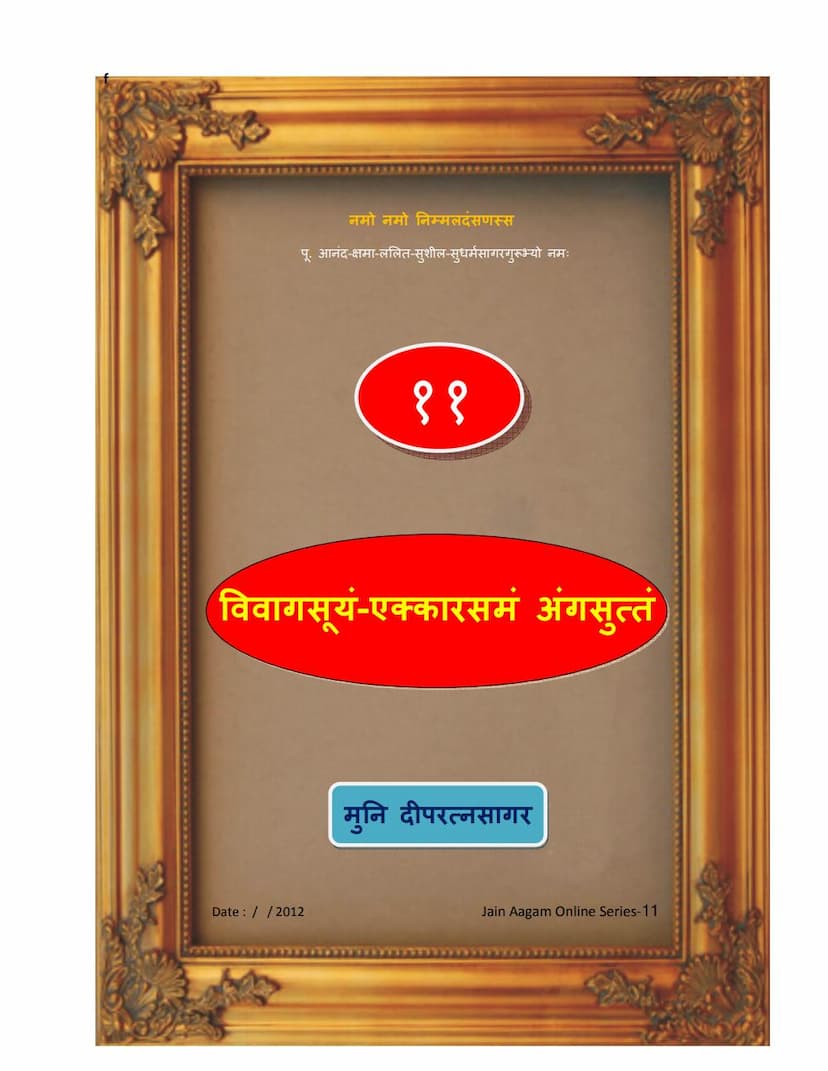Agam 11 Vivagsuya Ekkarasam Angsuttam Mulam PDF File
Added to library: September 1, 2025

Summary
Here is a comprehensive summary of the provided Jain text, Agam 11 Vivagsuya Ekkarasam Angsuttam Mulam:
Book Title: Agam 11 Vivagsuya Ekkarasam Angsuttam Mulam (The Eleventh Anga of Jain Agamas, Vivagasuya Sutra) Author(s): Dipratnasagar, Deepratnasagar Publisher: Deepratnasagar Content Focus: This text is the eleventh Anga (limb or scripture) of the Jain Agamas, known as the Vivagasuya (Sutra on Consequences of Actions). It details the karmic consequences (vipaka) of actions, categorized into those leading to suffering (duhkha-vipaka) and those leading to happiness (sukha-vipaka).
Structure and Key Themes:
The text is divided into two Srutakhandas (sections of knowledge):
- Duhkha-Vipaka (Consequences of Suffering): This section contains ten chapters (adhyayana), each illustrating the dire consequences of past actions that lead to suffering in the present life.
- Sukha-Vipaka (Consequences of Happiness): This section also contains ten chapters, demonstrating the positive outcomes and spiritual progress resulting from virtuous actions.
The primary narrative style is through stories of past lives and the karmic repercussions experienced by individuals. The text emphasizes the Jain principle of karma, where every action has a consequence, and these consequences manifest in future births and experiences.
Summary of the Chapters (Adhyayanas):
The provided text details the first ten chapters, which fall under the Duhkha-Vipaka section. Each chapter narrates the story of an individual who suffers due to past negative karma. The common structure for each chapter involves:
- Introduction: The chapter often begins with the disciple questioning the venerable Bhagavan Mahavir (or his chief disciple, Gautama Swami) about the karmic consequences of specific actions.
- Narrative of Past Lives: The core of each chapter is the story of an individual's past life, highlighting their wrongdoings (adverse actions, bad conduct, attachment to worldly pleasures, lack of compassion, etc.).
- Present Suffering: The text then describes how these past actions lead to severe suffering and afflictions in their current life. This suffering can manifest as physical ailments, disabilities, social ostracization, or intense emotional pain.
- Karmic Analysis: The spiritual preceptor explains the specific karma responsible for the current suffering, linking the past actions to the present misery.
- Future Transmigration: Finally, the text often outlines the future transmigrations of the individual, indicating the continuation of the karmic cycle unless spiritual progress is made.
Specific Chapter Summaries (as indicated by the provided text):
- Chapter 1: Miyaputta (son of Mia): Describes the suffering of Miyaputta, born blind, deaf, and deformed due to past actions. His mother cared for him, but his condition was a result of past negative karma.
- Chapter 2: Ujjhiyaya (abandoned): Narrates the story of Ujjhiyaya, who was abandoned by his parents due to his previous negative actions, leading to a life of hardship and suffering.
- Chapter 3: Abhagrasene: Details the suffering of Abhagrasene, who experienced extreme physical pain and torment due to past deeds, emphasizing the severe consequences of violence and cruelty.
- Chapter 4: Sagade: Illustrates the plight of Sagade, who faced immense difficulties and humiliation due to his past miserliness and attachment to wealth.
- Chapter 5: Bahssaidatte: Describes the suffering of Bahssaidatte, who was afflicted by numerous diseases and ailments as a consequence of his past harmful actions, possibly related to deceit or malice.
- Chapter 6: Nandivardhane: Focuses on Nandivardhane, whose life was marked by misfortune and lack of fulfillment due to his past impious actions and disregard for righteous conduct.
- Chapter 7: Umbardatte: Narrates the suffering of Umbardatte, who experienced unbearable pain and affliction due to past sins, possibly related to greed or unethical practices.
- Chapter 8: Soriyadatte: Details the story of Soriyadatte, whose life was filled with torment and distress due to past cruelties and disregard for living beings, particularly evident in his transmigration as a fisherman.
- Chapter 9: Devadatta: Describes the suffering of Devadatta, who faced severe consequences, including painful diseases and torment, as a result of her past misdeeds, possibly related to envy or manipulation.
- Chapter 10: Anju: Illustrates the suffering of Anju, whose existence was marked by misery and hardship due to past negative actions, possibly involving deceit or harmful speech.
Key Takeaways and Jain Principles Highlighted:
- Karma Siddhanta (Doctrine of Karma): The Vivagasuya is a profound exposition of the karma theory, demonstrating how every action, thought, and word creates karmic impressions that inevitably bear fruit.
- Consequences of Actions: The text meticulously details the cause-and-effect relationship between past deeds and present suffering, serving as a cautionary tale against unethical conduct.
- Importance of Right Conduct: By illustrating the dire consequences of negative actions, the scripture strongly advocates for righteous conduct, compassion, non-violence (ahimsa), truthfulness (satya), non-stealing (asteya), celibacy (brahmacharya), and non-possession (aparigraha).
- Spiritual Progression: While the first section focuses on suffering, the underlying message is that understanding these consequences can motivate individuals to adopt a spiritual path, practice austerities, and strive for liberation (moksha).
- Reincarnation: The concept of reincarnation is central, as individuals are shown to transmigrate through various life forms and realms based on their karma.
- Moral Instruction: The stories serve as powerful moral lessons, aiming to inspire adherence to the Jain path of liberation and deter individuals from engaging in harmful activities.
Overall Purpose:
The Vivagasuya, through its detailed narratives of suffering caused by negative karma, aims to educate individuals about the intricate workings of the karmic cycle. It serves as a guide to understand the repercussions of actions and to motivate the practice of virtues, leading to spiritual purification and eventual liberation from the cycle of birth and death. The text, as presented, focuses on the first ten chapters, detailing the consequences of negative actions, implying a continuation with the chapters on positive karmic outcomes.